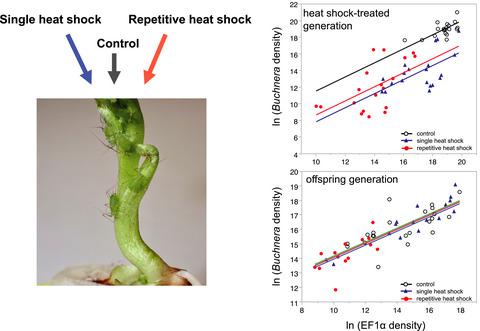当前位置:
X-MOL 学术
›
Entomol. Exp. Appl.
›
论文详情
Our official English website, www.x-mol.net, welcomes your feedback! (Note: you will need to create a separate account there.)
Heat shock alters pea aphid–Buchnera interactions: negative allometry of gene densities
Entomologia Experimentalis et Applicata ( IF 1.9 ) Pub Date : 2021-02-17 , DOI: 10.1111/eea.13039 Nousheen Parven 1, 2 , Izumi Yao 1 , Takashi Kanbe 1 , Shin‐ichi Akimoto 1
Entomologia Experimentalis et Applicata ( IF 1.9 ) Pub Date : 2021-02-17 , DOI: 10.1111/eea.13039 Nousheen Parven 1, 2 , Izumi Yao 1 , Takashi Kanbe 1 , Shin‐ichi Akimoto 1
Affiliation

|
In the face of global climate change, the understanding of how aphid‐symbiont relationships are affected by heat shock is critical. We evaluated the effects of heat shock on the pea aphid, Acyrthosiphon pisum Harris (Hemiptera: Aphididae), and its obligate endosymbiont Buchnera aphidicola Munson et al. by means of quantitative PCR in treated aphids and their offspring. First‐instar aphids received a single heat shock (35 °C for 6 h), repetitive heat shocks (repeat of the single heat shock for 3 days), or a control treatment (constant 20 °C). We evaluated the impacts on aphid body length and Buchnera and aphid gene densities, estimated from the number of copies of bacterial 16S‐rRNA and nuclear elongation factor 1‐alpha (EF1α) genes, respectively. Heat shock negatively affected aphid body length and Buchnera and EF1α gene densities. Heat‐shocked aphids contained lower densities of Buchnera and EF1α genes than control aphids when body length was kept constant. When Buchnera and EF1α gene densities were represented on a log–log scale, Buchnera densities increased with EF1α densities in all treatments, but Buchnera densities showed negative allometry with EF1α densities. Compared to control aphids, heat‐shocked aphids contained lower Buchnera densities relative to EF1α densities. Some heat‐shocked aphids became sterile if their Buchnera gene density was lower than a threshold (ca. 42 000 copies). The offspring of aphids subjected to a single heat shock recovered the number of Buchnera, but the offspring of aphids subjected to repetitive heat shocks exhibited markedly lower Buchnera and EF1α densities. Thus, heat shock negatively affects both aphid and Buchnera cell proliferation, in the heat shock‐treated generation as well as in their offspring, but the impact is more severe on Buchnera. Because the symbiont supplies essential amino acids, vitamins, and an essential protein, this could reduce aphid development and reproduction and possibly leads to extinction of local populations.
中文翻译:

热激改变豌豆蚜-布氏菌的相互作用:基因密度的负异构
面对全球气候变化,了解热冲击如何影响蚜虫-共鸣关系是至关重要的。我们评估了热激对豌豆蚜虫,蚜虫蚜(Acyrthosiphon pisum Harris)(半翅目:蚜虫)及其专性的内共生菌Buchnera aphidicola Munson等人的影响。通过定量PCR处理的蚜虫及其后代。初生蚜虫接受单次热激(35°C持续6 h),重复性热激(单次热激重复3天)或进行对照处理(恒定20°C)。我们评估了对蚜虫体长和Buchnera的影响和蚜虫基因密度,分别从细菌16S-rRNA和核伸长因子1-α(EF1α)基因的拷贝数估算。热休克对蚜虫的体长,Buchnera和EF1α基因的密度有负面影响。当体长保持恒定时,热激蚜虫的Buchnera和EF1α基因密度低于对照蚜虫。当鬼羽箭属和EF1α基因密度,对数坐标表示,鬼羽箭属密度在所有治疗EF1α密度增加,但鬼羽箭属密度表现出与EF1α密度负异速生长。与对照蚜虫相比,热激蚜虫的布氏杆菌含量较低相对于EF1α密度的密度。如果一些热休克的蚜虫的布奇纳菌基因密度低于阈值(约42000份),它们将变得不育。受到单次热激的蚜虫后代恢复了布氏菌的数量,但受到反复热激的蚜虫后代的布氏菌和EF1α密度明显降低。因此,热休克对经过热休克处理的一代及其后代的蚜虫和Buchnera细胞增殖均具有负面影响,但对Buchnera的影响更为严重。因为共生体提供必需的氨基酸,维生素和必需的蛋白质,所以这可能会减少蚜虫的发育和繁殖,并可能导致当地种群灭绝。
更新日期:2021-04-24
中文翻译:

热激改变豌豆蚜-布氏菌的相互作用:基因密度的负异构
面对全球气候变化,了解热冲击如何影响蚜虫-共鸣关系是至关重要的。我们评估了热激对豌豆蚜虫,蚜虫蚜(Acyrthosiphon pisum Harris)(半翅目:蚜虫)及其专性的内共生菌Buchnera aphidicola Munson等人的影响。通过定量PCR处理的蚜虫及其后代。初生蚜虫接受单次热激(35°C持续6 h),重复性热激(单次热激重复3天)或进行对照处理(恒定20°C)。我们评估了对蚜虫体长和Buchnera的影响和蚜虫基因密度,分别从细菌16S-rRNA和核伸长因子1-α(EF1α)基因的拷贝数估算。热休克对蚜虫的体长,Buchnera和EF1α基因的密度有负面影响。当体长保持恒定时,热激蚜虫的Buchnera和EF1α基因密度低于对照蚜虫。当鬼羽箭属和EF1α基因密度,对数坐标表示,鬼羽箭属密度在所有治疗EF1α密度增加,但鬼羽箭属密度表现出与EF1α密度负异速生长。与对照蚜虫相比,热激蚜虫的布氏杆菌含量较低相对于EF1α密度的密度。如果一些热休克的蚜虫的布奇纳菌基因密度低于阈值(约42000份),它们将变得不育。受到单次热激的蚜虫后代恢复了布氏菌的数量,但受到反复热激的蚜虫后代的布氏菌和EF1α密度明显降低。因此,热休克对经过热休克处理的一代及其后代的蚜虫和Buchnera细胞增殖均具有负面影响,但对Buchnera的影响更为严重。因为共生体提供必需的氨基酸,维生素和必需的蛋白质,所以这可能会减少蚜虫的发育和繁殖,并可能导致当地种群灭绝。


























 京公网安备 11010802027423号
京公网安备 11010802027423号